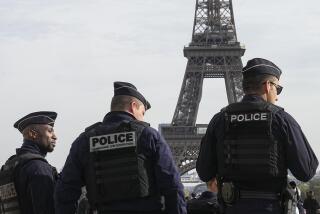IRA Phone Threats Bring London to Standstill
- Share via
LONDON — How to convulse a metropolis of 6 million before breakfast?
London was Monday’s gridlocked target in an escalating war of economic disruption, an example of IRA manipulation with what analysts say are chilling international implications. They describe it as a signal of the Irish Republican Army’s determination--and of its weakness.
“IRA Halts London by Phone,” read one banner headline.
Around 7 a.m. Monday, as the morning rush hour began to build, callers from phone booths delivered coded bomb warnings threatening London airports, railways, subways, highways, even an English Channel ferry port--in another raspberry to the British national election campaign now in its homestretch.
All the threats were hoaxes. There were no bombs and no injuries, unless you count the hundreds of thousands of Londoners and visitors delayed, diverted, bewildered and angry.
It was the sixth major IRA disruption in Britain since March 26, and mirrored what terrorist specialist Paul Rogers calls an “increasing global tendency toward economic targeting among terrorist groups.” Like the IRA, terrorists in Algeria, France, Spain, Japan and Sri Lanka are all partial to economic targets.
“The occasional bomb and four or five times as many warnings is a very effective strategy against an advanced industrial society,” said Rogers, adding that disruption keeps the IRA on the election agenda without provoking retaliation in Northern Ireland.
Several thousand Americans arriving on transatlantic flights were among 8,000 passengers trapped in their planes for hours on the tarmac at Gatwick Airport, where all 164 gates were occupied by planes that could not leave.
All rail and road links to Gatwick, about 25 miles south of London, were closed until after noon. One of the four terminals at closer-in Heathrow Airport was partly evacuated.
In addition to four airports in all, several highways and the ferry port at Dover received coded threats, as did the London rail stations of Kings Cross, Charing Cross, Paddington and St. Pancras and Baker Street station, a key subway junction. Police cordoned off about a quarter of a mile around the closed stations, interrupting bus service and other traffic.
While thousands milled about with nowhere to go, a BBC reporter encountered “deathly calm” in normally traffic-clogged Trafalgar Square.
“Basically, west and central London are closed,” said a spokesman for the Royal Automobile Club, lamenting “some of the worst traffic chaos we have seen in many years, if ever.” The worst-hit areas included the financial heart of London, known as the City, and west London areas that are a magnet for tourists.
The IRA, which is warring against British rule in Northern Ireland, refuses to declare a cease-fire before its political arm, Sinn Fein, is seated at all-party peace talks that opened in June. The British government says there is no room for Sinn Fein unless the IRA renounces violence.
Sinn Fein is running candidates in 17 of 18 Northern Ireland electoral districts in the May 1 elections expected to be won by the opposition Labor Party under Tony Blair. Gerry Adams, Sinn Fein’s leader, and two others may win, although the party typically draws only about 12% of the vote and runs second to a more moderate Roman Catholic nationalist party.
Before dawn Monday, terrorists thought to be Protestant militants exploded a small firebomb at Sinn Fein offices in the Catholic-majority city of Londonderry in Northern Ireland.
“The IRA has always believed from a publicity point of view that bombs, threats and attacks in London are worth 10 similar events in Northern Ireland,” said Paul Wilkinson, a terrorism specialist at St. Andrews University in Scotland. “The message they are trying to send is that nowhere and no one is safe.”
Business districts, energy resources, telecommunications and transportation systems are the four main targets for today’s terrorists, says Rogers, who teaches at the University of Bradford. Transportation systems are the easiest of the four to attack and have been the main target of the IRA’s current disruption campaign.
In the case of the IRA, cheap terror by telephone may reflect weakness within the organization after major arrests and the seizure of large quantities of weapons and explosives around London last summer, analysts believe.
“Planting big bombs is hard to do and carries heavy risks. They may not be capable of mounting a major attack,” Rogers speculated.
More to Read
Sign up for Essential California
The most important California stories and recommendations in your inbox every morning.
You may occasionally receive promotional content from the Los Angeles Times.










